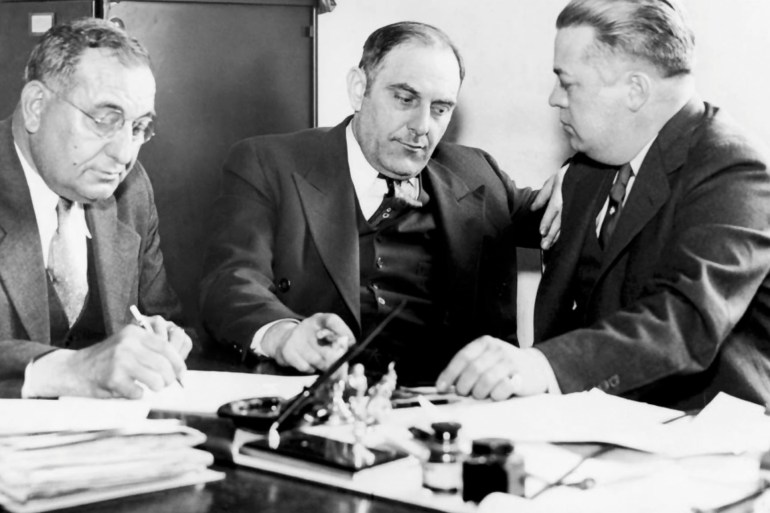Bernie Madoff, the mastermind of the biggest financial fraud in history, died recently at the age of 82 in a prison in North Carolina, to bring to mind the story of another fraudster known as Victor Lustig, who died 75 years ago in an American prison.
In a report published in the French newspaper L'Espoir de Saint-Sauveur, the writer Charles de Saint-Sauveur says that Madoff was able, through a major fraud, to reap, starting in December 2008, sums estimated at $ 65 billion, before falling into the hands of the police and being sentenced in a year. 2019, with 150 years in prison.
Similar conditions
Madoff, who died on April 14, submitted a request for release in 2020 due to his deteriorating health, stressing that he had a kidney disease and would not be able to live more than 18 months, but the US authorities ignored his request, before he actually passed away a few days ago. .
And 75 years before this incident, one of the most famous fraudsters of the twentieth century, Victor Lustig, also known as "Robert V Miller", died in similar circumstances, after 11 years in Alcatraz Prison in San Francisco Bay.
Madoff leaves the US Federal Court after a hearing on March 10, 2009 in New York (French)
Lustig died at the Federal Prisoner Health Center in Springfield on March 11, 1947, after suffering pneumonia and not receiving adequate treatment, after he submitted 1,192 medical requests during his 11 years in prison, and the authorities constantly ignored his requests in the belief that he was lying Out of jail.
From Paris to the United States
There is a lot of mystery surrounding the story of Victor Lustig, or Robert V Miller, especially since he used about 40 pseudonyms during the various scams.
Lustig was born in 1890 in the Czech Republic at the time of the Austro-Hungarian Empire, and was quickly known for his wit and ability to learn foreign languages, and he mastered 5 languages, including English and French.
His parents dreamed of their son becoming a lawyer or a diplomat, but he chose to take another path that would lead him to achieve his rich-quick ambitions.
He began his life as a gangster on the sidewalks of Paris, and became famous for a scar on his left cheek due to a brawl in a nightclub.
Later, he changed his field of activity to target passengers of luxury ships crossing the Atlantic, specifically the wealthy seeking luxury and entertainment.
At the poker tables, his trickery skill allowed him to get loads of cash, and before he turned 30, he became rich.
In 1914, World War I broke out and disrupted transatlantic flights, which deprived him of the activity from which he was reaping huge profits.
Eiffel Tower sale
Lustig then moved to the United States, a vast continent full of opportunity, and established his own empire with a brilliant dexterity in lying and fraud.
The assumption of the character of a young aristocrat forced by the war to emigrate to the United States, and his first victim was a banker from Kansas.
Lustig pretended to buy an old farmhouse, pay the banker fake dollars, before making $ 10,000 real for fake treasury bills.
Thanks to his ability to choose his victims well, Lustig made a lot of money in the United States before returning to Paris and carrying out his biggest blow there in the mid-1920s.
Mystery hangs around the beginning of the story, because the victim - a scrap dealer named André Boisson - has not filed a complaint against Lustig after being defrauded.
Lustig assumed the role of an important postal official, invited Poisson and 4 scrap metal dealers for lunch, and assured them that the Eiffel Tower, who weighed 7,300 tons of metal, was up for sale.
Lustig read to the ears of his guests an article describing the dilapidated condition of the historic monument, which had been eaten by rust and rejected by the public, and he claimed that the maintenance of the tower would be very expensive, so it was decided to put it up for sale.
Lustig stressed that his guests should maintain the utmost secrecy, because French President Domirue and only a few ministers knew about the matter, and the deal could fail if the news broke, and then he asked them to present their offers.
Lustig (center) was arrested in 1935 and had to deal with police officers as seen here during interrogation (French press)
The end of Lustig
Poisson was caught up in the ruse and he met Balustig again to pay the agreed amount and complete the deal, and when Poisson noticed and discovered that he was a victim of a fraud, Lustig was on his way to Austria to enjoy the money without fear of prosecution.
But in the absence of adequate legal arguments, Poisson was unable to file a lawsuit, and Lustig could have returned to Paris and spent the money safely, and it might have occurred to him to put the Eiffel Tower up for sale again.
Lustig then returned to the United States and specialized in making counterfeit dollar-printing machines, and he had many victims, before he was arrested in 1935 for forgery, and he was imprisoned in Alcatraz prison in San Francisco Bay.
Although he submitted a large number of requests to transfer him to another prison, he remained there until his transfer to the medical center and his death at the age of 57, and Lustig is said to have placed on the wall of his cell in California a postcard of the Eiffel Tower.

